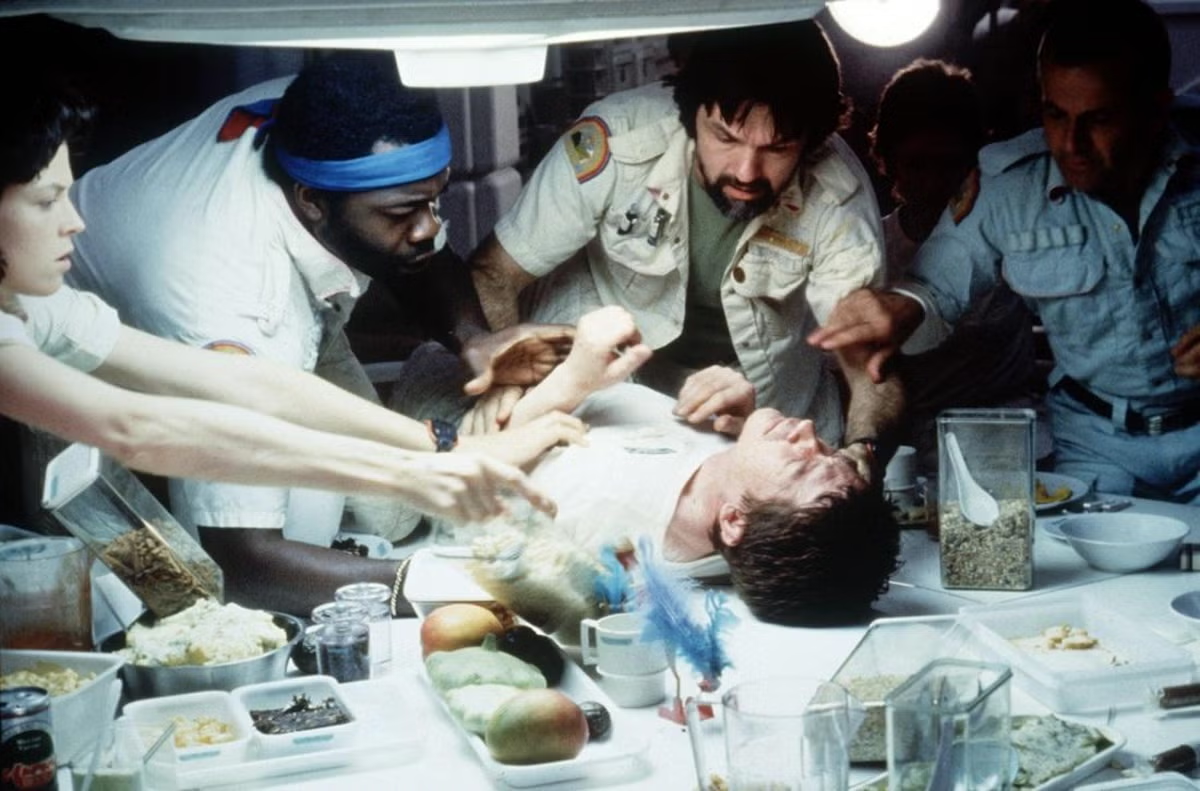Riddle me this: what do a starship named after a literary classic, a nightmarish creature designed by a surrealist artist, and a chest full of animal guts have in common? If you answered, “They’re all part of the Alien (1979) legacy,” you’re on the right track! Yep, Alien is one of those rare gems that keeps on giving, even decades after its release. It’s a film that redefined sci-fi horror and gave us one of the most terrifying creatures ever to slither across the screen. But beyond the iconic moments that everyone remembers, there’s a treasure trove of lesser-known facts that make this movie even cooler. So, let’s dive into some of the juiciest facts about Alien that even die-hard fans might have missed.
1. The Chestburster Scene Was a Real Shocker
Let’s kick things off with one of the most unforgettable moments in Alien—the chestburster scene. Now, you probably think you know everything about this gruesome sequence, but here’s the kicker: the reactions you see on screen were 100% real. Ridley Scott, being the sneaky genius he is, kept the full details of the scene under wraps, even from the cast. As Veronica Cartwright (who played Lambert) once spilled the beans, “We had no idea what was going to happen. They kept it a secret from us deliberately so our reactions would be real.”
The actors knew something was going to happen, but when that chestburster exploded out of Kane (played by John Hurt), the blood went flying—along with everyone’s nerves. Cartwright was so shocked that she actually fainted on set. Talk about commitment to realism! It’s no wonder this scene has become one of the most iconic in film history.
2. The Title Alien Was Almost Something Else
Here’s a fun little tidbit for you: Alien wasn’t always going to be called Alien. In the early stages, the movie was rocking the title Star Beast. Yep, you read that right. But screenwriter Dan O’Bannon wasn’t feeling it. “‘Alien’ was a noun and an adjective,” he explained in an interview, “and it just seemed to encapsulate everything we wanted to say.”
And boy, did that one-word title nail it. Not only does it perfectly describe the extraterrestrial menace, but it also captures the eerie, isolated vibe of the film. Sometimes, less is more—and in this case, it was so much more.
3. H.R. Giger’s Xenomorph Design: Nightmare Fuel

Now, let’s talk about the real star of the show: the Xenomorph. This isn’t just any movie monster—it’s a creation straight out of H.R. Giger’s wildest nightmares. Giger, a Swiss surrealist artist, was known for his “biomechanical” style, which mixed organic and mechanical elements in the most unsettling ways possible. His design for the Xenomorph was based on one of his earlier works, Necronom IV, and it’s safe to say that he knocked it out of the park.
RIDLEY SCOTT (DIRECTOR): Dan [O’Bannon] took me aside, like he was showing me a dirty book. It was Giger’s Necronomicon. My eyeballs nearly fell out. I flew to Zurich to meet him – Giger won’t fly. He was very straight, almost an artist engineer. A great practitioner. We had the Alien, from the book, and I said, “You’ve got it there, don’t change it. You’ve got lots of other things to design: the Egg, the Facehugger, the Chestburster…”
– Alien’s Chestburster Sequence: The Inside Story Behind One Of Cinema’s Most Shocking Scenes
“I wanted to create something that was both sexually alluring and terrifying at the same time,” Giger once said. Mission accomplished, H.R. Mission accomplished. The Xenomorph is unlike anything audiences had ever seen, and its haunting design has influenced countless other creatures in the sci-fi and horror genres.
4. Real Animal Organs Were Used for Extra Gore
If you thought the chestburster scene was gruesome on screen, just wait until you hear how they pulled it off behind the scenes. To make the moment as horrifyingly real as possible, the crew used actual animal organs from a local butcher shop. These were stuffed into a prosthetic chest, ready to burst out and make movie history.
Sure, it’s gross, but it’s that kind of dedication to authenticity that made Alien so unforgettable. The result? A scene so visceral that it still makes audiences squirm to this day.
5. The Nostromo’s Name Has a Literary Twist
Ever wondered where the name Nostromo came from? Well, it’s not just a cool-sounding name for a spaceship. Ridley Scott actually borrowed it from Joseph Conrad’s novel Nostromo: A Tale of the Seaboard. The book’s Nostromo is a trusted ship’s mate, a character whose loyalty and resilience echo some of the traits we see in Ripley, our badass heroine.
But wait, there’s more! The escape shuttle Ripley uses at the end of the film is named Narcissus, which is another nod to Conrad, specifically his novel The Nigger of the Narcissus. It’s just one more way that Alien weaves in layers of meaning, even in the smallest details.
Also, Read: Alien (1979) Movie Ending Explained
6. The Original Ending Was a Real Downer
Here’s one last fact about to blow your mind: the ending of Alien wasn’t always the uplifting escape we know and love. In the original script, things were looking pretty grim for Ripley. Instead of making it to the lifeboat, she was supposed to float off into space, presumably to die a slow, cold death. Yikes.
Luckily for us (and for Ripley), the filmmakers decided that audiences needed something a bit more hopeful after all that tension and terror. So, they rewrote the ending to let Ripley live to fight another day—setting her up to become one of cinema’s greatest heroines.









